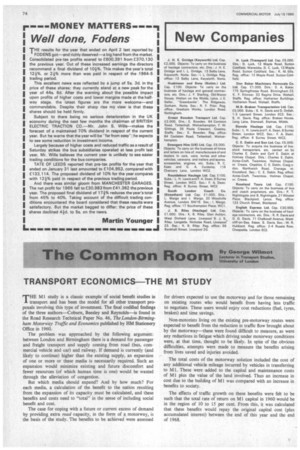The Common Roo
Page 76

If you've noticed an error in this article please click here to report it so we can fix it.
By George Wilmot
nilLecturer in Transport Studies, University of London
TRANSPORT ECONOMICS-THE Ml STUDY
THE M1 study is a classic example of social benefit studies in transport and has been the model for all other transport pro posals involving this type of investment. The final codified findings of the three authors—Coburn, Beesley and Reynolds—is found in the Road Research Technical Paper No. 46, The London-Birmingham Motorway Traffic and Economics published by HM Stationery Office in 1960.
The problem was approached by the following argument: between London and Birmingham there is a demand for passenger and freight transport and supply coming from road (bus, commercial vehicle and car) and railway. If demand is currently (and likely to continue) higher than the existing supply, an expansion of one or more or these media is necessarily required. Such an expansion would minimize existing and future discomfort and fewer resources (of which human time is one) would be wasted through the alleviation of congestion.
But which media should expand? And by how much? For each media. a calculation of the benefit to the nation resulting from the expansion of its capacity must be calculated, and these benefits and costs need to "total" in the sense of including social benefit and cost.
The case for coping with a future or current excess of demand by providing extra road capacity, in the form of a motorway, is the basis of the study. The benefits to be achieved were assessed
for drivers expected to use the motorway and for those remaining on existing routes who would benefit from having less traffic to negotiate. These users would enjoy cost reductions (fuel. tyres, brakes) and time savings.
Non-motorists living on the existing pre-motorway routes were expected to benefit from the reduction in traffic flow brought about by the motorway—these were found difficult to measure, as were any reductions in fatigue which driving under motorway conditions were, at that time, thought to be likely. In spite of the obvious difficulties, attempts were made to measure the benefits arising from lives saved and injuries avoided.
The total costs of the motorway solution included the cost of any additional vehicle mileage incurred by vehicles in transferring to Ml. These were added to the capital and maintenance costs of Ml plus the value of the land involved. Thus an increase in cost due to the building of MI was compared with an increase in benefits to society.
The effects of traffic growth on these benefits were felt to be such that the total rate of return on MI capital in 1960 would be in the region of 10 to 15 per cent. From this, it was calculated that these benefits would repay the original capital cost (plus accumulated interest) between the end of this year and the end of 1968.
























































































































